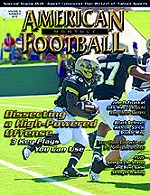AMERICAN FOOTBALL MONTHLY THE #1 RESOURCE FOR FOOTBALL COACHES
Article CategoriesAFM Magazine
|
The Importance of Formation Recognition© More from this issueBy Ryan Ruschhaupt, Assistant Coach Football is an ever evolving game where some of the most creative and intelligent coaches in sports find ways to defeat you merely by the alignment of players in a formation. Offensive coordinators search for alignment weaknesses in order to outflank a defense, while defenses utilize disguise in order to deceive and confuse an offense. Long gone are the days when we faced a team that stays in a pro-set offense or a base 4-3 the entire game. Offensive formations can be wide, tight or even unbalanced in just one series or even a set of downs. Modern American football dict....The full article can only be seen by subscribers.
|
|
|||||||
| HOME |
MAGAZINE |
SUBSCRIBE | ONLINE COLUMNISTS | COACHING VIDEOS |
Copyright 2025, AmericanFootballMonthly.com
All Rights Reserved





